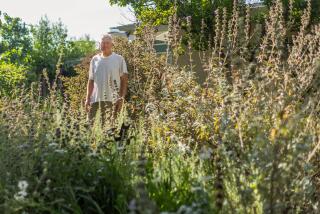This guy wants to end the world’s allergies and asthma - with plants
- Share via
A garden can be heaven on earth, a source of satisfaction, healing and physical activity, unless you have plant allergies. Then it can be sheer hell.
Author and landscaping expert Tom Ogren has a solution: His latest book, “The Allergy-Fighting Garden: Stop Allergies and Asthma With Smart Landscaping,” gives readers tips for planting a garden that not only is free of the most allergy-triggering plants but also includes plants that can mitigate and even block allergens.
For Ogren, the research for this and his other books has been nearly a lifelong project. “I was newly married [now going on 50 years], and my wife, Yvonne, was suffering from allergies and asthma. Right about that time I was reading a book by a psychologist who believed that allergies and asthma, which do tend to hit women hardest, were psychosomatic illnesses and that most of these conditions were emotional and mental. I believed it too and was quite unsympathetic.
“Then I started to study the connection between plants and allergies. I was on a landscaping job at a prison. There were lots of acacia trees around, and I noticed my workers sniffling and sneezing a lot. ... I realized how wrong I’d been and dug in for more research.”
And you could say it saved his marriage.
What Ogren found was that the plants producing the most allergy-triggering pollen were male plants and that more private and municipal plantings were using just male plants. “I’m not saying that female plants don’t produce pollen or that same-sex plants don’t, but my research found that the biggest problem came from plants that were male and producing pollen small enough to be a problem for allergies. And the world has gone hog-wild about using all male plants,” Ogren says.
The solutions that Ogren describes in his book are mostly about avoidance: using more female, fruit-and-berry-producing plants and creating a balance of male plants and the female plants that produce brightly colored flowers, large, sticky pollen, flowers with rich nectar and fragrances — but he also recommends plants that can act as pollen traps. He devised a scale, called the Ogren Plant Allergy Scale, or OPALS, which ranks plants according to factors such as the amount, potency, weight and size of the pollen produced (if any), how long the plant is in bloom, whether it attracts insects with smell and color, and other physical characteristics of a plant that determine whether its pollen is airborne. The book lists plants alphabetically, gives each an OPALS ranking and also teaches readers how to recognize these characteristics — as well as the sex of plants — on their own.
Many horticulturists and professors swear by Ogren’s work, but his call to balance out the male-to-female ratio in the garden is not without controversy. “I had a nursery owner accuse me of trying to kill the nursery industry by suggesting we use fewer male trees. I’m not saying that we shouldn’t use male trees, just that we need a balance.”
Ogren also suggests people get involved with city planners who are planting trees and bushes.






